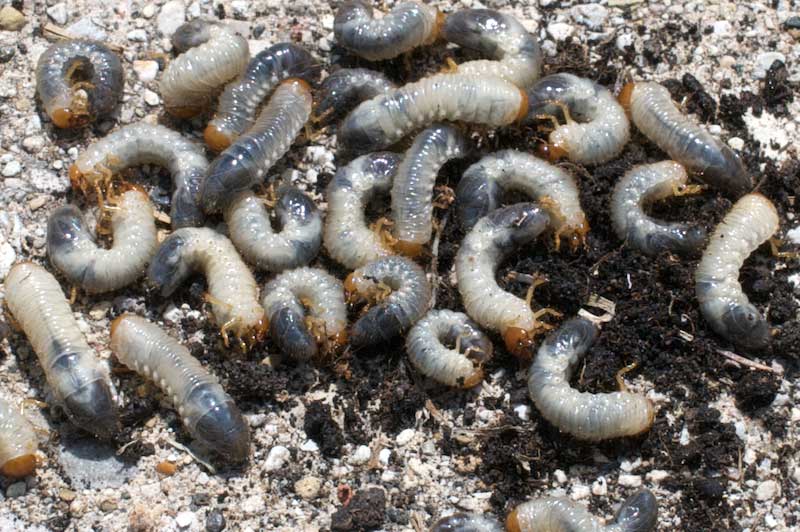Got grubs? Get the hot sauce!

“Grumble, grumble. Grubs again.” Photo: JB, Creative Commons, some rights reserved
At forty-two percent protein, they’re highly nutritious, and in many countries are considered a delicacy. Here in northern New York, we produce them in droves—lawn grubs, the immature form of beetles such as Japanese beetles, European Chafers, Oriental beetles, and the recently arrived Asiatic garden beetles. Grubs kill grass by eating roots to the point that it can be peeled up like a carpet. Damage can be compounded by skunks, moles, and crows grubbing for the tasty critters.
The time grubs best succumb to treatment, either natural or chemical, is when they’re small, generally in mid- to late August. Right now, mature grubs are thinking about pupation, after which they’ll emerge as beetles. The only way to rout them at this juncture would be to hire a surfeit of skunks. Then you’d have other problems.
One bright spot in the Battle of the Grubs is that a recently approved chemical appears to be both very effective and non-toxic, two things which unfortunately don’t always go together. It poses no threat to bees, which has been a concern with imidacloprid, a very popular grub control chemical. In 2013, the European Union issued a two-year ban on imidacloprid in light of research suggesting it may adversely affect honey bees.
This name of this new compound, chlorantraniliprole, is a tongue twister, but it’s important to know so you can be sure you’re getting the right stuff. It’s available to homeowners under the brand name GrubEx™. Sometimes it can take a year or two for an older formulation to work its way out of the supply chain, so check the label to be sure that you’re getting chlorantraniliprole.
As mentioned, timing is critical for successful grub control because their most vulnerable life stage is in late summer. It can be confusing though, because different chemicals take varying lengths of time to become effective. Chlorantraniliprole takes 60-90 days to work and should be applied by the end of May, at the latest, in order to kill grubs in August. Products containing other chemicals are available, each with its own application schedule.
Imidacloprid takes 30+ days to reach maximum effectiveness and has to be applied in June to mid-July. The chemical in fast-acting “24-hour” grub products is either trichlorfon or carbaryl. This type of product is applied in late summer. Both active ingredients are highly toxic, so keep children, pets, and wildlife away from treated areas for at least a day following application.
According to Cornell, our soils are too cool for milky spore disease, a biological grub control, to survive. However, beneficial nematodes, which are near-microscopic soil organisms that attack most grub species, are quite effective. Plus they’re nontoxic and don’t harm other organisms. Beneficial nematodes are fragile, and must be applied soon after they arrive. They can be ordered online, or ask at your local garden center.
Because applying grub chemicals in the spring is a poor choice, the best thing to do is to reseed bare spots now and to mow high — 3-4 inches — so the grass will make stronger roots.
Or you could mix some batter, fire up the deep fryer and go grub up some dinner from the lawn.
PESTICIDE DISCLAIMER: Every effort has been made to provide correct, complete and up-to-date pesticide recommendations. Nevertheless, changes in pesticide regulations occur often, and human errors are still possible. These recommendations are not a substitute for pesticide labeling. Please read the label before applying any pesticide and follow the directions exactly.
Paul Hetzler is a horticulture and natural resources educator with Cornell Cooperative Extension of St. Lawrence County.







